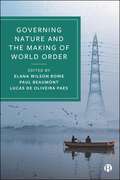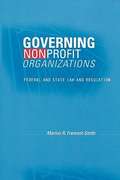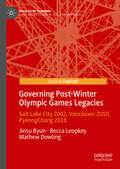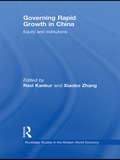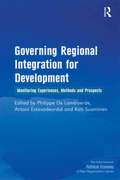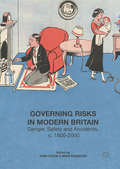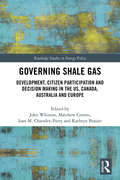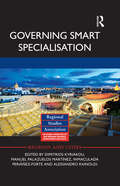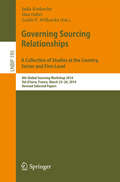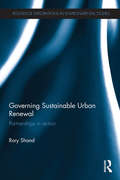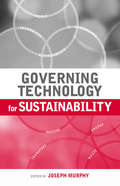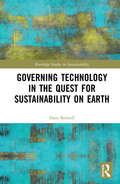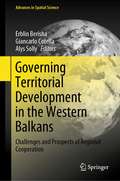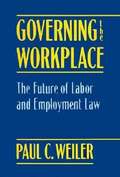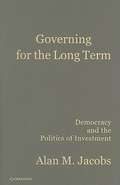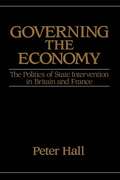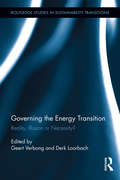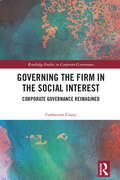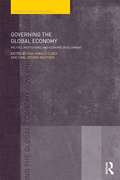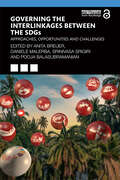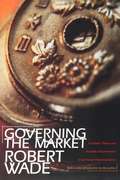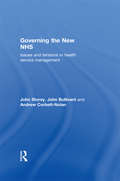- Table View
- List View
Governing Nature and the Making of World Order
by Elana Wilson Rowe, Paul Beaumont and Lucas de Oliveira PaesAvailable open access digitally under CC-BY-NC-ND licence. How have efforts to govern nature and address urgent global environmental challenges shaped, transformed or undermined processes of world ordering? Chapters in this book explore how efforts to govern nature have transformed – or are transforming – how we understand and practice world politics. Bringing together a team of contributors from around the world, the book traces this inquiry across diverse international policy fields, from security and peacebuilding through science cooperation and governing ecosystems to the politics of economic growth. Taken together, the book offers a conceptually ambitious and empirically grounded account of how the governance of nature and the making of world order intertwine and calls for a research agenda to attend to the growing impact of this interrelationship.
Governing Nonprofit Organizations: Federal and State Law and Regulation
by Marion R. Fremont-SmithThe nonprofit sector is a vital component of our society and is allowed the greatest freedom to operate. The public understandably assumes that since nonprofit organizations are established to do good, the people who run nonprofits are altruistic, and the laws governing nonprofits have reflected this assumption. But as Marion Fremont-Smith argues, the rules that govern how nonprofits operate are inadequate, and the regulatory mechanisms designed to enforce the rules need improvement. Despite repeated instances of negligent management, self-interest at the expense of the charity, and outright fraud, nonprofits continue to receive minimal government regulation. In this time of increased demand for corporate accountability, the need to strengthen regulation of nonprofits is obvious. Fremont-Smith addresses this need from a historical, legal, and organizational perspective. She combines summaries and analysis of the substantive legal rules governing the behavior of charitable officers, directors, and trustees with descriptions of the federal and state regulatory schemes designed to enforce these rules. Her unique and exhaustive historical survey of the law of nonprofit organizations provides a foundation for her analysis of the effectiveness of current law and proposals for its improvement.
Governing PG&E
by Lynn Sharp Paine Will HurwitzThe five commissioners of the California Public Utilities Commission (CPUC) listened intently at a public forum in April 2019 as PG&E Corporation's out-going chairman Richard Kelly described the company's proposed new board. PG&E, which provided electricity and natural gas to millions of Californians, had once been recognized for its vision in foreseeing energy's potential to reshape the state and power its economy. But PG&E was now in the crosshairs of investors, regulators, and the public for something else entirely: its role in a series of deadly and destructive wildfires that had ravaged the region and precipitated PG&E's bankruptcy months earlier. Called "the first climate-change bankruptcy," it was the largest utility bankruptcy in U.S. history. The commissioners at the CPUC, PG&E's primary regulator, were particularly concerned about PG&E's governance and had convened the forum to solicit opinions from experts and the public and to hear for themselves what steps the company was taking to improve it. The Commissioners are considering whether to make specific recommendations regarding the board's composition and functioning, including how the board assesses and compensates PG&E's CEO. A principal issue is the use of non-financial metrics to evaluate and reward CEO performance.
Governing Post-Winter Olympic Games Legacies: Salt Lake City 2002, Vancouver 2010, PyeongChang 2018 (Mega Event Planning)
by Mathew Dowling Jinsu Byun Becca LeopkeyThis book provides a comprehensive analysis of post-Games legacy governance including stakeholder relationships, institutional conditions, and policy environments, while also empirically exploring the modes of governance employed by select cases of the Winter Olympic Games. This work offers insights to help practitioners develop and manage the governance of legacy more effectively. Theoretical and methodological implications, as well as future avenues of research are suggested.
Governing Rapid Growth in China: Equity and Institutions (Routledge Studies in the Modern World Economy #Vol. 78)
by Ravi Kanbur Xiaobo ZhangAfter three decades of spectacular economic growth in China, the problem is no longer how to achieve growth, but how to manage its consequences and how to sustain it. The most important consequence, at least as far as Chinese policy makers are concerned, is the rapidly growing inequality, between persons, between rural and urban areas, and between inland and coastal regions. At the same time, the institutions that have brought rapid growth so far are now under stress, and there is a need to reform and innovate on this front in order to sustain rapid growth, and to have growth with equity. The analytical literature has responded to the emerging policy problems by specifying and quantifying their magnitude, understanding their nature, and proposing policy approaches and solutions. Policy makers have also been looking to analysts for interaction and assistance. This volume brings together a collection of the best available analyses of China’s problems in governing rapid growth, focusing on equity and institutions. Contributions include perspectives from leading policy makers who were intimately involved in the reform process, and from leading academics in articles published in top peer reviewed journals.
Governing Regional Integration for Development: Monitoring Experiences, Methods and Prospects (The International Political Economy of New Regionalisms Series)
by Antoni EstevadeordalDeveloping countries have joined the rapidly growing global system of regional trade agreements (RTAs) over the past years. The drive towards regional integration has advanced with the formation of new markets and groups in Latin America, Africa, Asia, the Middle East and Oceania with few developing countries remaining outside these regional schemes. This volume looks at how 'getting governance right' is a central element for successful RTA implementation, taking stock of the quality and effectiveness of the monitoring of development country RTAs around the world. Organized by the main world regions and primarily focusing on developing country RTAs, the book also includes two case studies focused on monitoring in developed country regional agreements by way of comparison. The contributors operationalize governance in the context of RTA implementation with a more narrow and technical term of 'monitoring' and provide eight important lessons for assessing monitoring around the world.
Governing Risks in Modern Britain
by Tom Crook Mike EsbesterFormore than 200 years, everyday life in Britain has been beset by a variety ofdangers, from the mundane to the life-threatening. Governing Risks in Modern Britain focuses on the steps taken tomanage these dangers and to prevent accidents since approximately 1800. Itbrings together cutting-edge research to help us understand the multiple andcontested ways in which dangers have been governed. It demonstrates that thecategory of 'risk', broadly defined, provides a new means of historicising somekey developments in British society. Chapters explore road safety and policing,environmental and technological dangers, and occupational health and safety. Thebook thus brings together practices and ideas previously treated in isolation, situatingthem in a common context of risk-related debates, dilemmas and difficulties. Doingso, it argues, advances our understanding of how modern British society hasbeen governed and helps to set our risk-obsessed present in some much neededhistorical perspective.
Governing Shale Gas: Development, Citizen Participation and Decision Making in the US, Canada, Australia and Europe (Routledge Studies in Energy Policy)
by John Whitton Matthew Cotton Ioan M. Charnley-Parry Kathy BrasierShale energy development is an issue of global importance. The number of reserves globally, and their potential economic return, have increased dramatically in the past decade. Questions abound, however, about the appropriate governance systems to manage the risks of unconventional oil and gas development and the ability for citizens to engage and participate in decisions regarding these systems. Stakeholder participation is essential for the social and political legitimacy of energy extraction and production, what the industry calls a 'social license' to operate. This book attempts to bring together critical themes inherent in the energy governance literature and illustrate them through cases in multiple countries, including the US, the UK, Canada, South Africa, Germany and Poland. These themes include how multiple actors and institutions – industry, governments and regulatory bodies at all scales, communities, opposition movements, and individual landowners – have roles in developing, contesting, monitoring, and enforcing practices and regulations within unconventional oil and gas development. Overall, the book proposes a systemic, participatory, community-led approach required to achieve a form of legitimacy that allows communities to derive social priorities by a process of community visioning. This book will be of great relevance to scholars and policy-makers with an interest in shale gas development, and energy policy and governance.
Governing Smart Specialisation (Regions and Cities)
by Dimitrios Kyriakou Manuel Palazuelos Martínez Inmaculada Periáñez-Forte Alessandro RainoldiIn recent years, smart specialisation has been a key building block of regional economic and development policy across the European Union. Providing targeted support for innovation and research, it has helped identify those areas of greatest strategic potential, developing mechanisms to involve the fullest range of stakeholders, before setting strategic priorities and using the policy to maximize the knowledge-based potential of a region or territory. Governing Smart Specialisation contributes to the emerging debate about the role of the ‘entrepreneurial discovery process’ (EDP), which is at the heart of smart specialisation strategies for regional economic transformation. Particular focus in placed on what methods, procedures and institutional conditions are necessary in order to generate information that helps buttress policy decisions. It draws on existing literature that analyses the relevance of EDP within smart specialisation for regional policy. Chapters are complemented with case studies about regions with different geographical and socioeconomic characteristics in Europe: from Norwegian regions to the Greek region of East Macedonia and Thrace. As one of the first books to directly address the EDP, this is essential reading for students interested in regional economics, public policy, urban studies and technology innovation, as well as for policy makers in regional and national administrations.
Governing Sourcing Relationships. A Collection of Studies at the Country, Sector and Firm Level
by Julia Kotlarsky Ilan Oshri Leslie P. WillcocksThis book contains 11 papers from the 8th Workshop on Global Sourcing, held in Val d'Isère, France, during March 23-26, 2014, which were carefully reviewed and selected from 42 submissions. They are based on a vast empirical base brought together by leading researchers in information systems, strategic management, and operations. This volume is intended for students, academics, and practitioners interested in research results and experiences in outsourcing and offshoring of information technology and business processes. Topics discussed in this book combine theoretical and practical insights regarding challenges that industry leaders, policy makers, and professionals face; and they predominantly focus on how sourcing relationships are governed at the national, industry, and firm level. The contributions also examine current and future trends in outsourcing, paying particular attention to cloud services and their impact on the outsourcing sector.
Governing Sustainability
by W. Neil Adger Andrew JordanThe crisis of unsustainability is, above all else, a crisis of governance. The transition to a more sustainable world will inevitably require radical changes in the actions of all governments, and it will call for significant changes to the lifestyles of individuals everywhere. Bringing together some of the world's most highly regarded experts on governance and sustainable development, this book examines these necessary processes and consequences across a range of sectors, regions and other important areas of concern. It reveals that the governance of sustainable development is politically contested, and that it will continue to test existing governance systems to their limits. As an assessment of existing policy practices, it will be of great interest to all those who are preparing themselves - or their organisations - for the sustainability transition.
Governing Sustainable Urban Renewal: Partnerships in Action (Routledge Explorations in Environmental Studies)
by Rory ShandEnvironmental and sustainability issues are currently stretched by economic concerns and policy areas such as housing and education are therefore needed more than ever to help regenerate the social and urban environment. Governing Sustainable Urban Renewal: Partnerships in Action uses detailed case studies from the UK, Germany and USA to explore the effect of institutional design and modes of governance and evaluates policy outputs, outcomes and best practice. In doing so, it illustrates where power and decision making lies in the delivery of urban renewal initiatives and examines the roles for communities in the governance process. The analysis offers insight into the formation of partnerships and networks that can help to overcome many of the obstacles faced in urban renewal and in the promotion of sustainable development in core urban areas. Given the increasing commitment of governments throughout the world to renewal as a means for resolving entrenched environmental, social and governance problems, this timely new study should be of interest to students and researchers across a range of disciplines including environment studies, geography, public policy, governance and politics, sustainable development, planning and urban studies.
Governing Technology for Sustainability
by Joseph MurphyIn a world of growing complexity and dwindling resources, the relationship between technology and sustainability is a pressing issue of concern at the highest levels. This book improves our understanding by examining the ways that people, technology and governance shape each other with implications for sustainability. It is the first book to link technology studies and governance research to this problem. Contributions from leading environmental social scientists are included, with each chapter reporting on new research and tackling complex, but vital issues. Drawing on examples such as wave and tidal power, wind power, micro-generation, community waste recycling and eco-housing, the book provides powerful new insights into the governance of technology for sustainability. A detailed introduction and conclusion discuss existing research directions and identify the contribution that the book makes in advancing our understanding of the people-technology-governance nexus and its implications for sustainability. This is essential reading for all those in academia, government and industry working at the critical interface between how we develop, deploy and govern technology in the pursuit of sustainability.
Governing Technology in the Quest for Sustainability on Earth (Routledge Studies in Sustainability)
by Dain BolwellGoverning Technology in the Quest for Sustainability on Earth explores how human technologies can be managed to ensure the long-term sustainability of our species and of other life forms with which we share this world. It analyses human impact, the discourses of environmentalism and issues of economics, history and science. As these variables are complex, drawing on issues from the social, physical and life sciences as well as the humanities, Dain Bolwell uses an interdisciplinary approach to investigate these concepts and their related public policies. Exploring three major existing and emerging technologies – chemical herbicides, nuclear-electric power generation, and robotics and artificial intelligence – the book demonstrates the multifaceted and complicated nature of the grand challenges we face and draws out the measures required to effect sustainability in the wider political sphere. Exploring how we can govern technology most effectively to ensure a long term and sustainable future, this book will be of great interest to students and researchers of environmental studies, science and technology and environmental law and policy.
Governing Territorial Development in the Western Balkans: Challenges and Prospects of Regional Cooperation (Advances in Spatial Science)
by Giancarlo Cotella Erblin Berisha Alys SollyThis book offers a multifaceted overview of the evolution of spatial development, governance and planning in the Western Balkans from an institutionalist perspective. Written by experts in the field, it features various regional and national studies covering topics such as regional and spatial planning, territorial development and governance, and regional and cross-border cooperation in the Western Balkans. Offering a wealth of national, regional and local insights on territorial cooperation, development and planning, this book will appeal to scholars in regional and spatial sciences and related fields alike.
Governing The Workplace: The Future Of Labor And Employment Law
by Paul C. WeilerLabor lawyer Paul Weiler examines the social and economic changes that have profoundly altered the legal framework of the employment relationship. He not only discusses a wide range of issues, from wrongful dismissal to mandatory drug testing and pay equity, but he also develops a blueprint for the reconstruction of the law of the workplace, especially designed to give American workers more effective representation.
Governing for the Long Term
by Alan M. JacobsIn Governing for the Long Term, Alan M. Jacobs investigates the conditions under which elected governments invest in long-term social benefits at short-term social cost. Jacobs contends that, along the path to adoption, investment-oriented policies must surmount three distinct hurdles to future-oriented state action: a problem of electoral risk, rooted in the scarcity of voter attention; a problem of prediction, deriving from the complexity of long-term policy effects; and a problem of institutional capacity, arising from interest groups' preferences for distributive gains over intertemporal bargains. Testing this argument through a four-country historical analysis of pension policymaking, the book illuminates crucial differences between the causal logics of distributive and intertemporal politics and makes a case for bringing trade-offs over time to the center of the study of policymaking.
Governing the "Chinese Dream": Corruption, Inequality and the Rule of Law
by Rafael Di Tella Meg Rithmire Kaitlyn SzydlowskiXi Jinping assumed his position as head of China's fifth generation of leaders in 2012. Xi was head of both the People's Republic of China and the Chinese Communist Party, which had ruled China since 1949. Xi inherited a country far more unequal than the one that Mao Zedong, Communist China's first leader, had left behind in 1978. The growth of markets had made China much wealthier, but also generated many social problems, including inequality, corruption, and social protests. This case discusses China's political and economic development in the 20th century to situate Xi's-and China's-contemporary challenges.
Governing the Economy: The Politics of State Intervention in Britain and France (Europe And The International Order Ser.)
by Peter A. HallFor over one hundred years, the British economy has been in decline relative to other industrialized countries. <p><p>This book explores the origins of Britain's economic problems and develops a striking new argument about the sources of decline. It goes on to analyze the evolution of economic policy in postwar Britain from the development of Keynesianism to the rise of monetarism under Margaret Thatcher. France, by contrast, experienced an economic miracle in the postwar period. <p><p>Hall argues that the French state transformed itself and then its society through an extensive system of state intervention. In the recent period, however, the French system has encountered many difficulties, and the book locates their sources in the complex interaction between state and society in France culminating in the socialist experiment of Francois Mitterrand. <p><p>Through his insightful, comparative examination of policy-making in Britain and France, Hall develops a new approach to state-society relations that emphasizes the crucial role of institutional structures.
Governing the Energy Transition: Reality, Illusion or Necessity? (Routledge Studies in Sustainability Transitions)
by Derk Loorbach Geert VerbongThe Energy Transition, the inevitable shift away from cheap, centralized, largely fossil-based energy systems, is one of the core challenges of our time. This book provides a coherent and novel insight into the nature of this challenge and possible strategies to accelerate and guide such transitions. It brings together prominent European scholars and practitioners from the fields of energy transition research and governance to draw attention to the current complex dynamics in the energy domain, and offer elegant and provocative explanations for current crises and lock-ins. They identify multiple energy transition pathways that emerge and increasingly compete, and emphasize the need and possibilities for novel governance. By analysing the complexity of energy transition processes and the difficulties in shifting to sustainable pathways, this text questions the extent to which actually governing energy transitions is already reality, just an illusion, or a bare necessity.
Governing the Firm in the Social Interest: Corporate Governance Reimagined (Routledge Studies in Corporate Governance)
by Catherine CaseyThe corporate business enterprise is a core institution of capitalism. It holds immense political, economic, and cultural power in society. It mobilizes social and planetary resources to its utility in pursuit of private profit maximization and with little regard for social concerns. Its influence over so much of societal life and effects on the natural environment raise critical questions about the firm and its governance in democratic society. Various voices seek reforms of regulation and corporate governance practices to those shaped by the neoliberal policies persisting in the current decades. But prospects for amelioration within our current horizons of thinking appear elusive. This book contributes a distinctly social theoretical approach to the social problem of governing the firm. Its discussions complement debates in economics, politics, and law. Its critical social theorizations challenge conventional understandings of the firm and neoliberal legitimacies of its governance and posit alternatives. The book explores the social relations and moral fabric of the firm and the creativity of human action at work. It proposes a reimagined corporate governance premised on just recognition of that social vitality. It invites unprecedented collaboration for a robust participatory democracy for governing the firm and market action oriented to ecological and social sustainability.
Governing the Global Economy: Politics, Institutions and Economic Development (Routledge Studies in Globalisation)
by Dag Harald Claes Carl Henrik KnutsenGoverning the Global Economy explores the dynamic interaction between politics and economics, between states and markets and between international and domestic politics. The contributors study how the governance of the global economy is shaped by interaction between international institutions, domestic politics and multinational enterprises, from a wide range of theoretical perspectives and methods. Presenting a fresh approach to the study of international political economy, this volume covers: the systemic characteristics of the liberal world order, the role of international institutions, domestic economic politics and policies the strategies and behaviour of multinational enterprises. The volume also includes topical discussion of the challenges to the global economy from the recent financial crisis and analysis of economic politics, in particular the regions of Africa and Europe as well as the countries of Japan and South Korea. With contributions from prominent scholars in political science, economics and business studies, who have all contributed greatly to advancing the study of political economy over the last decade, Governing the Global Economy aims to bridge the gap between undergraduate textbooks and advanced theory. It is essential reading for all students and scholars of international political economy and globalization.
Governing the Interlinkages between the SDGs: Approaches, Opportunities and Challenges
by Anita Breuer Daniele Malerba Srinivasa Srigiri Pooja BalasubramanianGoverning the Interlinkages between the SDGs: Approaches, Opportunities and Challenges identifies the institutional processes, governance mechanisms and policy mixes that are conducive to devising strategies of integrated Sustainable Development Goal (SDG) implementation. The book edited by Anita Breuer, Daniele Malerba, Srinivasa Srigiri and Pooja Balasubramanian examines the dedicated policies targeting the SDGs, as well as political and institutional drivers of synergies and trade-offs between the SDGs in selected key areas – both cross-nationally and in specific country contexts. Their analysis moves beyond the focus on links between SDG indicators and targets. Instead, the book takes advantage of recent evidence from the initial implementation phase of the SDGs and each chapter explores the question of which political-institutional prerequisites, governance mechanisms and policy instruments are suited to accelerate the implementation of the SDGs. The findings presented are intended to both inform high-level policy debates and to provide orientation for practitioners working on development cooperation. This volume will be of great interest to practitioners and policy makers in the field of sustainable development, as well as academics in the fields of sustainability research, political science, and economics.
Governing the Market: Economic Theory and the Role of Government in East Asian Industrialization
by Robert WadePublished originally in 1990 to critical acclaim, Robert Wade's Governing the Market quickly established itself as a standard in contemporary political economy. In it, Wade challenged claims both of those who saw the East Asian story as a vindication of free market principles and of those who attributed the success of Taiwan and other countries to government intervention. Instead, Wade turned attention to the way allocation decisions were divided between markets and public administration and the synergy between them. <p><p>Now, in a new introduction to this paperback edition, Wade reviews the debate about industrial policy in East and Southeast Asia and chronicles the changing fortunes of these economies over the 1990s. He extends the original argument to explain the boom of the first half of the decade and the crash of the second, stressing the links between corporations, banks, governments, international capital markets, and the International Monetary Fund. From this, Wade goes on to outline a new agenda for national and international development policy.
Governing the New NHS: Issues and Tensions in Health Service Management
by John Storey John Bullivant Andrew Corbett-NolanThe new NHS is a very different organisation to the one set up 60 years ago. Two decades of reforms have introduced a market element, unprecedented transparency, patient choice, new incentives, devolved accountabilities and a host of new regulatory bodies. All these changes have made governance a crucial and contested issue in health care. Governing the New NHS makes sense of the new systems and will enable anyone interested in healthcare governance to navigate their way confidently through the maze. It describes, assesses and critiques the new governance arrangements. It examines how they are working in practice and how practitioners are responding. The book: explains current governance arrangements and explores related issues and tensions discusses the roles and interrelationships of boards and effective board practice offers a range of practical tools and frameworks. Each chapter is supplemented with expert witness statement written by leading practitioners in the health system. This practical book will be invaluable to all those interested in health governance, policy and management - whether academic, student or practitioner.
